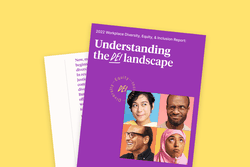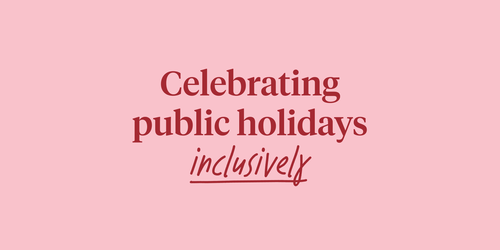
How to empower diverse teams: A guide for new managers

No one is born a perfect leader.
The people you admire and look to for inspiration gain wisdom through mistakes and challenges. And even the workplace culture influencers you follow will agree that continued success requires continuous learning.
So, if you feel like you’re struggling to manage a diverse mix of people on your team, fear not. Everyone has to begin somewhere, and it’s better to start now than never.
In this article, we cover a range of skills that new managers can develop to help create safe environments for diverse teams to thrive. There is no standard way to set yourself or your team up for success, especially in diversity management, so we’ve offered numerous avenues.
Challenges of managing a diverse team
First, it's important to acknowledge and address the challenges of managing a diverse group of people. Moreover, many of these challenges may not be evident until you’re in a leadership position.
Common challenges that leaders face include:
- Inexperience: You suddenly become responsible for a group of diverse people with different identities, backgrounds, and experiences. Many of these are ones you don't have and can’t see – moreover, some of these people may embody experiences or realities that you didn't even know existed. As a result, inexperience can be a major obstacle in setting every team member up for success.
- Intersectionality: When you look at your team, you might see or be provided with visual and disclosed markers of diversity. For example, race, gender, and age. But diversity can also refer to a larger range of qualities that a team or individuals embody. This could include (but is not limited to) different sexual orientations, cultures, political affiliations, socioeconomic status, religions, and physical abilities.
- Bias: Sometimes, even if our self-awareness can help us identify some gaps in diversity, our biases can hinder us from seeing others. For example, as a manager who strongly identifies with and thinks about their gender and race, you can assess whether or not your team is inclusive of people of different races and genders. But you might not be as quick to think about an imbalance of other diversity markers like physical ability or political affiliation.
Skills to develop when managing diverse teams
Becoming a leader makes you responsible for being aware of gaps in diversity and recalibrating how you move through your workplace. This involves becoming a supportive, aware leader, which can help you develop your diverse team to perform better, be healthier, and thrive.
But you can only reap the benefits of a thriving, diverse team if you manage them effectively. To begin your development in this area, there are several formal systems and soft skills you can focus on honing.
Formalized systems
Outlets for feedback
Outlets for feedback are important in every team, especially those full of differing opinions.
Formal avenues for feedback between managers and team members make everyone accountable for speaking up. They allow for every voice to be officially accounted for and every opinion to be valued. They also give you, the manager, access to insights about challenges facing your team members, or faults you can improve on.
Whether you implement digital surveys or face-to-face 1-on-1 meetings, you open the door for differing opinions to be voiced when you manage a diverse team. In an environment where the identity of your team or direct reports differs from yours, you might not see or understand something that causes an issue for other people. Prep yourself and your team to give constructive, safe feedback.
Conflict management skills
Conflict mediation may bring to mind some intimidating images. A manager acting as a third wheel in a conflict between two fuming employees. Or a manager sitting between two groups that refuse to see eye-to-eye, bottlenecking a project and lowering employee morale.
Instead, try thinking of conflict mediation as a positive exercise that could allow the diversity of your team to be a catalyst for growth.
Some of the most common causes of conflict include different needs, values, customs, and violation of personal boundaries – all factors impacting teams with diverse people. And at the root of many of these types of conflicts is miscommunication.
Consider conflict management training for yourself and your entire team. This will take the pressure off of you to be the only person capable of handling difficult situations. But it will also allow individuals to eventually identify and handle their own diversity, equity, and inclusion-related issues.
Additional learning and development opportunities could include:
- Unconscious bias training helps teams understand and identify how unconscious biases are brought into the workplace.
- Perspective-taking includes exercises to help employees develop more empathy and understand a colleague's perspective.
- Cross-cultural coaches can help managers understand the cultural differences that impact teams (e.g., teams including ex-pats, businesses that operate across borders, and global executives)

Demystify the DEI landscape
Soft skills
Emotional intelligence and self-awareness
Not all managers enter their roles with the crucial level of consciousness around how their identity impacts them as leaders. Over the course of our lives, we are all impacted by societal pressures and norms, which can result in overt and unconscious biases. The influences of media, stereotypes, and personal experiences in stereotypical workplaces can influence us in several ways. For example:
- Men promote and compensate women differently than they would other men in the same positions
- People design workplaces that don’t consider a range of physical abilities
- People from a particular social group continuously hire those that mirror their interests and community
- HR leaders responsible for structuring holiday closures can fail to recognize holidays that fall outside of their own religious practice
Whether or not we like it, we bring prejudices and habits into the office. But exercising your self-awareness will allow you to identify what biases, habits, and resulting in harmful actions you act out with your colleagues.
To exercise and grow your emotional intelligence, consider getting to know yourself better. Ask yourself the few questions below to uncover how your own identity could influence how your employees interpret your actions.
How might your race, gender, or socio-economic status impact:
- The way you make decisions about hiring?
- The way you speak with different individuals?
- The way you delegate tasks around the office?
- The way your organization handles celebrations or social events?
Good communication skills
There are many ways that good communication skills can be applied to teams. This includes how you communicate with the group as a whole and with individuals. It also applies to how you encourage those individuals to communicate with each other.
As the leader of a diverse team, creating environments that foster open communication across the board shows that you value varied voices and opinions.
Utilize and show good communication skills by:
- Being comfortable communicating about difficult situations and topics to show your team that you are willing to be vulnerable
- Managing conflicts by encouraging both sides of the situation to communicate effectively and respectfully
Empathy
Empathizing with the experiences of employees can not only help you respond better to conflicts. It can also help you proactively shape environments where diverse workers will thrive and perform better.
Truly listening when your employees voice concerns can help you understand each individual's experience. You can then apply those insights to shape an environment that helps everyone thrive.
For example, you might see an employee's physical demeanor change at the office. You know they’ve received a huge new project but assumed they would be excited. Instead of jumping to conclusions, consider inviting them to discuss what they’re actually experiencing.
In a shallow conversation, you could hear them say they’re “too busy” and interpret it as bad time management. But if you empathize and ask the right questions, you could hear that they’re missing time with their family to be at work because systems aren’t in place to help them be efficient.
Similarly, you could interpret their feeling overwhelmed as meaning they’re not up for the job. But instead, if you listen deeply, you’ll hear that they are excited to be committed to the project but need specific tools they weren’t trained on before taking the project.
When you invite active listening and empathy into a conversation, it allows you to solve the real problems that employees suffer from. Wondering if you can actually become more empathetic while keeping professional boundaries? Michael Ventura, CEO of Sub Rosa, says:
"It’s a teachable, learnable skill… Having empathy is a subjective skill. Empathy is not about being nice, it’s about understanding. If you really train that muscle you can actually get to a place where that understanding becomes second nature.”
Good cultural intelligence
Though you might not be born with a high level of cultural intelligence, it’s important to develop so that you can support diverse team members.
According to the Cultural Intelligence Center, “Cultural intelligence or quotient (CQ) is the ability to relate and work effectively with people from different cultural backgrounds, and it goes beyond existing notions of cultural sensitivity and awareness.”
You can up your CQ by learning about your team members' varied backgrounds and experiences. But note that when you begin seeking resources specific to your team’s makeup, you should avoid burdening individuals to teach you. Don’t make any single individual or group do all of the labor when teaching about their identity. Rather, start with resources that are published, public, and from credible outlets, organizations, or researchers.

Get a complete guide to DEI in the workplace
Do you have managers who manage diverse teams?
Share this article with your managers, letting them know:
- What you’ve noticed they’re doing well with the management of their diverse team (recognizing their existing strengths in the area)
- What types of training you’re willing to fund for them to develop into more inclusive leaders
- What types of training you’re willing to fund for their teams to make the workplace a safer space for the unique identities present
You can also share these additional readings to help them continue to grow their cultural intelligence and leadership skills:
- Cultivating meaningful change for Black people in the workplace
- 4 ways to support and amplify your Latinx employees
- 10 performance review biases and how to avoid them
- How to strike a balance between autonomy and support
- Effective managers: An HR guide
- 5 quick wins to help you be a better manager
- How to give feedback across cultures




